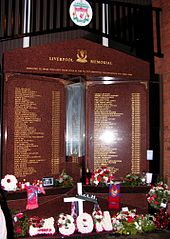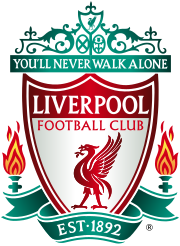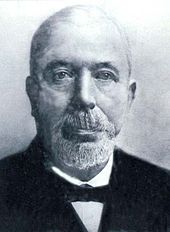Liverpool was founded in 1892 and joined the
Football League the following year. The club has played at
Anfield since its formation. The most successful period in Liverpool's history was the 1970s and '80s when
Bill Shankly and
Bob Paisley led the club to eleven league titles and seven European trophies.
The club's supporters have been involved in two major tragedies. The first was the
Heysel Stadium disaster in 1985 in which charging Liverpool fans caused a wall to collapse, killing 39
Juventus supporters and resulting in English clubs being banned from European competitions for five years. In the 1989
Hillsborough disaster, 96 Liverpool supporters lost their lives in a crush against perimeter fencing.
History
Liverpool F.C. was founded following a dispute between the
Everton committee and
John Houlding, club president and owner of the land at
Anfield. After eight years at the stadium, Everton relocated to
Goodison Park in 1892 and Houlding founded Liverpool F.C. to play at Anfield.
[3] Originally named "Everton F.C. and Athletic Grounds Ltd" (Everton Athletic for short), the club became Liverpool F.C. in March 1892 and gained official recognition three months later, after
The Football Association refused to recognise the club as Everton.
[4] The team won the
Lancashire League in its début season, and joined the
Football League Second Division at the start of the 1893–94 season. After finishing in first place the club was promoted to the
First Division, which it won in 1901 and again in 1906.
[5]
Liverpool reached its first
FA Cup Final in
1914, losing 1–0 to
Burnley It won consecutive League championships in 1922 and 1923, but did not win another trophy until the 1946–47 season, when the club won the First Division for a fifth time.
[6] Liverpool suffered its second Cup Final defeat in 1950, playing against Arsenal.
[7] The club was relegated to the Second Division in the 1953–54 season.
[8] Soon after Liverpool lost 2–1 to non-league
Worcester City in the 1958–59 FA Cup,
Bill Shankly was appointed manager. Upon his arrival he released 24 players and converted a boot storage room at Anfield into a room where the coaches could discuss strategy; here, Shankly and other "
Boot Room" members
Joe Fagan,
Reuben Bennett, and
Bob Paisley began reshaping the team.
[9]
The club was promoted back into the First Division in 1962 and won it in 1964, for the first time in 17 years. In 1965, the club won its first FA Cup. In 1966, the club won the First Division but lost to
Borussia Dortmund in the
European Cup Winners' Cup final.
[10] Liverpool won both the League and the
UEFA Cup during the 1972–73 season, and the FA Cup again a year later. Shankly retired soon afterwards and was replaced by his assistant, Bob Paisley.
[11] In 1976, Paisley's second season as manager, the club won another League and UEFA Cup double. The following season, the club retained the League title and won the
European Cup for the first time, but it lost in the 1977 FA Cup Final. Liverpool retained the European Cup in 1978 and regained the First Division title in 1979.
[12] During Paisley's nine seasons as manager Liverpool won 21 trophies, including three European Cups, a UEFA Cup, six League titles and three consecutive
League Cups; the only domestic trophy he did not win was the FA Cup.
[13]
Paisley retired in 1983 and was replaced by his assistant, Joe Fagan.
[14] Liverpool won the League, League Cup and European Cup in Fagan's first season, becoming the first English side to win three trophies in a season.
[15] Liverpool reached the European Cup final again in 1985, against
Juventus at the
Heysel Stadium. Before kick-off, Liverpool fans breached a fence which separated the two groups of supporters, and charged the Juventus fans. The resulting weight of people caused a retaining wall to collapse, killing 39 fans, mostly Italians. The incident became known as the
Heysel Stadium disaster. The match was played in spite of protests by both managers, and Liverpool lost 1–0 to Juventus. As a result of the tragedy, English clubs were banned from participating in European competition for five years; Liverpool received a ten-year ban, which was later reduced to six years. Fourteen Liverpool fans received convictions for involuntary manslaughter.
[16]

The Hillsborough memorial, which is engraved with the names of the 96 people who died in the
Hillsborough disaster.
Fagan resigned after the disaster and
Kenny Dalglish was appointed as
player-manager.
[17] During his reign, the club won another three League Championships and two FA Cups, including a League and Cup "
Double" in the 1985–86 season. Liverpool's success was overshadowed by the
Hillsborough disaster: in an FA Cup semi-final against
Nottingham Forest on 15 April 1989, hundreds of Liverpool fans were crushed against perimeter fencing.
[18] Ninety-four fans died that day; the 95th victim died in hospital from his injuries four days later and the 96th died nearly four years later, without regaining consciousness.
[19] After the Hillsborough disaster there was a government review of stadium safety. The resulting
Taylor Report paved the way for legislation that required top-division teams to have all-seater stadiums. The report ruled that the main reason for the disaster was overcrowding due to a failure of police control.
[20]
Liverpool was involved in the closest finish to a league season during the 1988–89 season. Liverpool finished equal with
Arsenal on both points and goal difference, but lost the title on total goals scored when Arsenal scored the final goal in the
last minute of the season.
[21]
Dalglish cited the Hillsborough disaster and its repercussions as the reason for his resignation in 1991; he was replaced by former player
Graeme Souness.
[22]Under his leadership Liverpool won the 1992 FA Cup Final. Souness was replaced by
Roy Evans, and Liverpool went on to win the 1995 Football League Cup Final.
Gérard Houllier was appointed co-manager in the 1998–99 season and became the sole manager in November 1998 after Evans resigned.
[23] In 2001, Houllier's second full season in charge, Liverpool won a "
Treble": the FA Cup, League Cup and UEFA Cup.
[24] Houllier underwent major heart surgery during the 2001–02 season and Liverpool finished second in the League, behind Arsenal.
[25]
Houllier was replaced by
Rafael Benítez at the end of the 2003–04 season. Despite finishing fifth in Benítez's first season, Liverpool won the
2004–05 UEFA Champions League, beating
A.C. Milan 3–2 in a
penalty shootout after the match ended with a score of 3–3.
[26] The following season, Liverpool finished third in the Premier League and won the 2006 FA Cup Final, beating
West Ham United in a penalty shootout after the match finished on 3–3.
[27] American businessmen
George Gillett and
Tom Hicks became the owners of the club during the 2006–07 season, in a deal which valued the club and its outstanding debts at £218.9 million.
[28] The club reached the 2007 UEFA Champions League Final against Milan, as it had in 2005, but this time Liverpool lost 2–1.
[29] During the 2008–09 season Liverpool achieved 86 points, its highest Premier League points total, and finished as runners up to
Manchester United.
[30]
In the 2009–10 season, Liverpool finished seventh in the Premier League and failed to qualify for the Champions League. Benítez subsequently left by mutual consent
[31] and was replaced by
Fulham manager
Roy Hodgson.
[32] At the start of the 2010–11 season Liverpool was on the verge of bankruptcy and the club's creditors asked the High Court to allow the sale of the club, overruling the wishes of Hicks and Gillett.
John W. Henry, owner of the Boston Red Sox and of New England Sports Ventures, bid successfully for the club and took ownership in October 2010.
[33] Poor results during the start of that season led to Hodgson leaving the club by mutual consent and former manager Kenny Dalglish taking over.
[34] After finishing in 8th position in the 2011–12 season, the worst league finish in 18 years,
[35] Dalglish was sacked.
[36] He was replaced by
Brendan Rodgers.
[37]
Colours and badge
Liverpool's home colours (1892–1896)
[38]
For much of Liverpool's history its home colours have been all red, but when the club was founded its kit was more like the contemporary Everton kit. The blue and white quartered shirts were used until 1894, when the club adopted the city's colour of red.
[3] The city's symbol of the liver bird was adopted as the club's badge in 1901, although it was not incorporated into the kit until 1955. Liverpool continued to wear red shirts and white shorts until 1964, when manager Bill Shankly decided to change to an all red strip.
[38] Liverpool played in all red for the first time against
Anderlecht, as
Ian St. John recalled in his autobiography:
He [Shankly] thought the colour scheme would carry psychological impact—red for danger, red for power. He came into the dressing room one day and threw a pair of red shorts to Ronnie Yeats. "Get into those shorts and let's see how you look", he said. "Christ, Ronnie, you look awesome, terrifying. You look 7ft tall." "Why not go the whole hog, boss?" I suggested. "Why not wear red socks? Let's go out all in red." Shankly approved and an iconic kit was born.
[39]
The Liverpool away strip has more often than not been all yellow or white shirts and black shorts, but there have been several exceptions. An all grey kit was introduced in 1987, which was used until the 1991–92 centenary season, when it was replaced by a combination of green shirts and white shorts. After various colour combinations in the 1990s, including gold and navy, bright yellow, black and grey, and
ecru, the club alternated between yellow and white away kits until the 2008–09 season, when it re-introduced the grey kit. A third kit is designed for European away matches, though it is also worn in domestic away matches on occasions when the current away kit clashes with a team's home kit. The current kits are designed by
Warrior Sports, who became the club's kit providers at the start of the 2012–13 season.
[40] The only other branded shirts worn by the club were made by
Umbro until 1985, when they were replaced by
Adidas, who produced the kits until 1996 when
Reebok took over. They produced the kits for ten years before Adidas made the kits from 2006 to 2012.
[41]
Liverpool was the first English professional club to have a sponsor's logo on its shirts, after agreeing a deal with
Hitachi in 1979.
[42] Since then the club has been sponsored by
Crown Paints,
Candy,
Carlsberg and
Standard Chartered Bank. The contract with Carlsberg, which was signed in 1992, was the longest-lasting agreement in English top-flight football.
[43] The association with Carlsberg ended at the start of the 2010–11 season, when Standard Chartered Bank became the club's sponsor.
[44]
The Liverpool badge is based on the city's
liver bird, which in the past had been placed inside a shield. In 1992, to commemorate the centennial of the club, a new badge was commissioned, including a representation of the
Shankly Gates. The next year twin flames were added at either side are symbolic of the Hillsborough memorial outside Anfield, where an
eternal flame burns in memory of those who died in the Hillsborough disaster.
[45] In 2012, Warrior Sports' first Liverpool kit removed the shield and gates, returning the badge to what had adorned Liverpool shirts in the 1970s; the flames were moved to the back collar of the shirt, surrounding the number 96 for number who died at Hillsborough.
[46]



